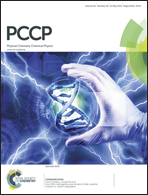Solid state chemistry of nitrogen oxides – Part I: surface consumption of NO
Abstract
The role of nitrogen and oxygen chemistry in the interstellar medium is still rather poorly understood. Nitric oxide, NO, has been proposed as an important precursor in the formation of larger N- and O-bearing species, such as hydroxylamine, NH2OH, and nitrogen oxides, NO2 and N2O. The topic of this study is the solid state consumption of NO via oxygenation and the formation of NO2 and other nitrogen oxides (ONNO2 and N2O4) under conditions close to those encountered on icy grains in quiescent interstellar clouds. In our experiments nitric oxide and oxygen allotropes (O, O2, and O3) or N atoms are co-deposited under ultra-high vacuum conditions on different substrates (silicate, graphite, compact ASW ice, and gold) at temperatures ranging between 10 and 35 K. Reaction products are monitored via Fourier Transform Reflection Absorption Infrared Spectroscopy (FT-RAIRS) and Temperature Programmed Desorption (TPD) using mass spectrometry. We find that NO2 is efficiently formed in NO + O/O2/O3/N solid surface reactions. These are essentially barrier free and offer a pathway for the formation of NO2 in space. Nitrogen dioxide, however, has not been astronomically detected, contradicting the efficient reaction channel found here. This is likely due to other pathways, including regular hydrogenation reactions, as discussed separately in part II of this study.


 Please wait while we load your content...
Please wait while we load your content...